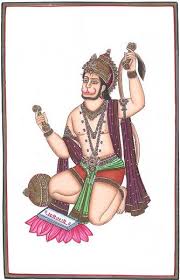Today, I am going to tell you about very powerful and strong god named as Lord Hanuman. He finds an important place in Ramayana. He was a devotee of Lord Rama, a form (avatar) of Vishnu, a god of Hindus. Hanuman is a figure of strength, perseverance ad devotion...
Hanuman:-
In Hinduism, Hanuman (Sanskrit: हनुमान्, IAST: Hanumān) is
an ardent devotee of Rama. Lord Hanuman, known as the Lord of
Celibacy was an ideal "Bhramchari" or called Naistika Brahmachari in
Sanskrit and is one of the central characters of the Indian Epic Ramayana. As
one of the Chiranjivi, he is also mentioned in several other texts, such
as the Mahabharata and the various Puranas. Hanuman is the son
of Anjani and Kesari and is also son of the wind-god Vayu,
who according to several stories, played a role in his Avatar.
If yoga is the ability to control one's
mind then Hanuman is the quintessential yogi having a perfect mastery over his
senses, achieved through a disciplined lifestyle tempered by the twin streams
of celibacy and selfless devotion (bhakti). In fact, Hanuman is the ideal
Brahmachari (one who follows the path of Brahma), if ever there was one. He is
also a perfect karma yogi since he performs his actions with detachment, acting
as an instrument of destiny rather than being impelled by any selfish motive.
While Hanuman is one of the central
characters in the ancient Hindu epic Ramayana, the evidence
of devotional worship to him is missing in the texts and archeological sites of
ancient and most of the medieval period. According to Philip Lutgendorf, an
American Indologist known for his studies on Hanuman, the theological
significance and devotional dedication to Hanuman emerged about 1,000 years
after the composition of the Ramayana, in the 2nd millennium CE,
after the arrival of Islamic rule in the Indian Subcontinent Bahkti
Movement saints such as Samarth Ramdas expressed Hanuman as a symbol
of nationalism and resistance to persecution. In the modern era, his
iconography and temples have been increasingly common. He is viewed as the
ideal combination of "strength, heroic initiative and assertive
excellence" and "loving, emotional devotion to his personal god
Rama", as Shakti and Bhakti. In later literature, he
has been the patron god of martial arts such as wrestling, acrobatics, as well
as meditation and diligent scholarship. He symbolizes the human
excellences of inner self control, faith and service to a cause, hidden
behind the first impressions of a being who looks like an Ape-Man Vanara.
Hanuman is stated by scholars to be the
inspiration for the allegory-filled adventures of a monkey in
the Xiyouji (Journey to the West) – the great Chinese poetic novel
influenced by the travels of Buddhist monk Xuanzang (602–664 CE) to
India.







No comments:
Post a Comment